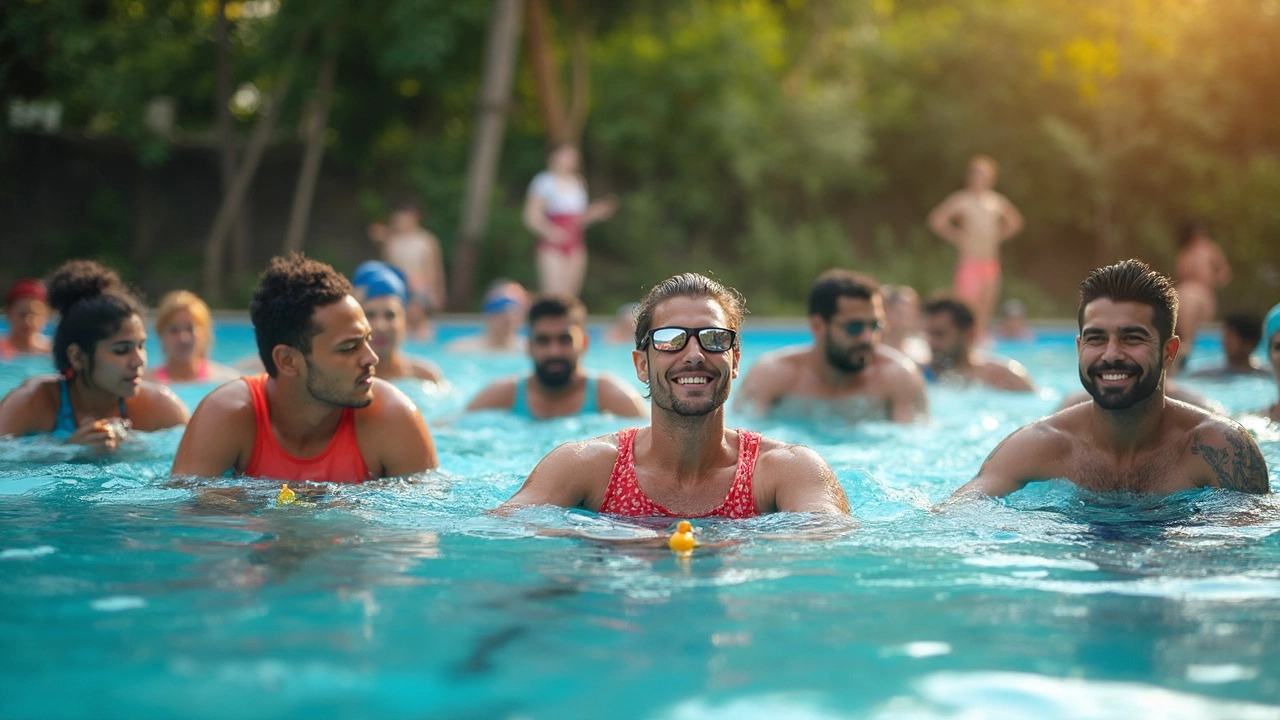Swimming always pops up when people are looking for ways to drop a few pounds. But does splashing around in a pool actually help you lose weight? Turns out, swimming can torch calories, especially if you know a few tricks and avoid wasting time just floating on your back.
The cool part is, water adds resistance. Your muscles work harder without you even noticing, compared to the regular gym grind. According to the American Heart Association, just half an hour of steady swimming can burn anywhere between 200-400 calories, depending on how hard you go and which stroke you use. That's on par with a fast-paced walk or light jog, except here, your joints aren’t taking a beating.
Most folks give up on swimming for weight loss because they expect fast results or just paddle lazily. Hang in there—it does work, but it's not magic. Like with everything else, it’s about consistency. The more you move, the more you burn. And if you combine swimming with a decent diet, you’ll see much bigger changes—without feeling like you live at the gym.
- How Swimming Burns Calories
- Swimming Techniques That Boost Results
- Common Pitfalls to Avoid
- Weight Loss Swim Tips from Real Swimmers
How Swimming Burns Calories
Swimming is like a secret weapon for burning calories, and you don’t have to be Michael Phelps to see results. When you swim, your body pushes against water resistance, which is way tougher than working out in air. This means your muscles work harder and you use up more energy, so you burn more calories than you might with some other workouts.
The exact number of calories burned comes down to your weight, the swim stroke, and how hard you go. Here’s a quick look at some numbers for a person weighing around 155 pounds:
| Swim Stroke | Calories Burned in 30 Minutes |
|---|---|
| Freestyle (moderate) | ~250 |
| Freestyle (vigorous) | ~400 |
| Butterfly | ~400 |
| Backstroke | ~200 |
| Breaststroke | ~250 |
Just to compare, a 30-minute brisk walk usually burns about 150 calories for that same person. So, if burning calories is your main goal, swimming can definitely get you there faster, especially with strokes like freestyle and butterfly.
What makes swimming stand out is the afterburn. Your body keeps working to recover even after you’re done, which means you’ll keep burning more calories long after you towel off. Plus, swimming uses almost all the major muscle groups—arms, legs, core, and back.
If you want to make your swimming sessions even more effective for weight loss, try mixing up your pace with sprints or intervals. You can also switch strokes during your workout for variety and to keep different muscles guessing. Just staying consistent is what moves the needle.
Swimming Techniques That Boost Results
If you want to shed weight in the pool, the way you swim matters more than you might think. People who hop in and slowly paddle from one end to the other won’t see the same results as someone picking up the pace or switching up their strokes. Certain techniques crank up the calorie burn and target more muscles at once.
Let’s look at popular swimming strokes and the kind of calorie burn you can expect:
| Stroke | Calories Burned (30 mins, 70kg person) |
|---|---|
| Freestyle (fast) | ~400 |
| Breaststroke | ~300 |
| Backstroke | ~250 |
| Butterfly | ~450 |
For max results, don’t stick to just one stroke. Rotate through freestyle, breaststroke, and butterfly in your workout. This keeps things fresh and forces your body to adapt, which leads to better swimming performance and better fat burn.
Intervals are another game-changer. Instead of swimming at the same speed the whole time, try going hard for one lap, then easy for the next. This gets your heart rate up and helps you torch more calories in a shorter session. Here’s a simple approach:
- Swim one lap as fast as you can
- Swim one lap slowly to recover
- Repeat this 8-10 times
If you get bored easily (I do), pool accessories like kickboards and pull buoys help target specific muscle groups. A kickboard will torch your legs, while a pull buoy focuses the work on your upper body. Both help add variety and can push you past plateaus.
One more tip: log your swim sessions and times, same as you would with running or cycling. Watching your laps and times improve keeps you motivated and helps you spot what’s working. If you stick to these focused techniques, you’ll get a lot more out of your swim workouts—both in pool skills and how your jeans fit.

Common Pitfalls to Avoid
A lot of people jump into swimming thinking the fat will just melt away, but there are some common mistakes that hold many back from seeing real weight loss.
- Not Pushing Yourself Enough: Easy laps or slow floating doesn’t do much. If your goal is to lose weight, you’ve got to get your heart rate up and really move.
- Ignoring Technique: Bad form wastes energy and can even make you tire out too soon. Taking a lesson or two helps more than most realize.
- Skipping Consistency: Swimming just once a week might feel good, but it’s not enough. Aim for at least 2-3 times a week to see any changes.
- Overestimating Calories Burned: It’s easy to feel super hungry after swimming and then overeat, thinking you've burned more calories than you actually have. That post-swim snack can turn into a full meal if you’re not careful.
- Sticking to the Same Routine: Your body adapts fast. Mix up your strokes and try some interval work to keep challenging yourself.
Check out this table for a quick comparison of calories burned with different swimming strokes during 30 minutes by a person weighing around 70 kg (roughly 155 lbs):
| Swimming Stroke | Calories Burned (30 min) |
|---|---|
| Freestyle (moderate pace) | 255 |
| Breaststroke | 315 |
| Backstroke | 240 |
| Butterfly | 400 |
Chasing variety and keeping your workouts fresh can make a big difference. And remember, swimming isn’t some magic fix—pair it with a balanced diet. Tracking progress, either with a swim watch or an app, lets you spot where you’re improving or slacking off. Staying honest with yourself is the real game changer.
Weight Loss Swim Tips from Real Swimmers
If you want to see real changes from swimming, you’ve got to do more than just splash around. People who actually lost weight with swimming follow a few key habits. Here’s what they said worked best for them (and what the science backs up):
- Mix up your strokes. Don’t just stick with freestyle. Switching between breaststroke, backstroke, and butterfly keeps things interesting and hits different muscle groups. It also prevents your body from getting too comfortable and burning fewer calories.
- Set a timer. Most regulars in the pool claim a 30–45 minute swim, three times a week, makes a noticeable difference. It gives your body enough workload to count as real exercise, especially if you cut down on those long breaks at the wall.
- Focus on intensity. Easy laps are fine for warmups, but adding short bursts or intervals—like sprinting for one length and recovering on the way back—cranks up the calorie burn fast. Think “swim hard for two laps, rest for 30 seconds, repeat.”
- Bring a buddy. Real swimmers swear having someone else in the lane keeps you honest and motivated. You’ll show up more often and push harder without even noticing.
- Track your progress. Whether you use a waterproof watch or just count laps, tracking helps you see improvements and stay on track. Almost everyone who loses weight with swimming pays attention to what they’re actually doing in the pool.
Here’s an extra tip from someone in my own circle: My friend Ben lost 10 kilos in six months by swapping his pizza night with a pool night. Small changes matter, and building that swim habit into your week pays off if you’re aiming for weight loss the smart way.
Just remember, swimming works for weight loss when you make it a real workout—not a poolside chill session. If you add a bit of structure and bring some effort, the changes will come. Stick with it, and you’ll understand why swimming is more than just fun—it gets real results.





